VR market will be worth $70 billion by 2020 according to TrendForceNoticia:According to research firm TrendForce, the VR market will be worth a huge $70 billion by 2020, a market that includes both the VR hardware, and software.
TrendForce said that VR hardware will be worth around $20 billion by 2020, but the software side of things is where the money will be made, with an estimated $50 billion by the end of the decade. TrendForce expects to see VR generate around $6.7 billion of revenue in 2016, with most of it coming from the sales of VR headsets, like the Oculus Rift and HTC Vive.
The research firm's wearable device analyst, Jason Tsai, said: "These explosive growth projections actually do not sufficiently reflect just how hot the VR industry is right now. The figures do not include the value of non-commercial uses of VR technology. For example, the industry is currently pushing the development of free software and do-it-yourself apps. While these projects do not immediately generate revenue for the developers, they have a vital role in the promotion market growth and innovations".
TrendForce also thinks that social media will be a big part of VR applications, with VR content being shared easily amongst social media users. Tsai added: "The development of the VR industry is not solely based on wearable devices launched by major hardware vendors such as Sony, Oculus and HTC. Much of the growth drive also comes from independent developers that contribute innovative apps to the VR industry. Their market value is not often reflected in the data. Since making apps does not have a high entry barrier, there has been a proliferation of non-commercial software made by students, independent developers and content providers. Instead of being guided by immediate commercial interests, they aim to attract consumers' attention with innovative products".
I thought I'd reach out to Anshel Sag, VR Analyst at Moor Insights & Strategy about the VR market being worth $70 billion by 2020, he told us exclusively: "$70 billion by 2020 is more than extremely ambitious, $70 billion assumes that VR is a mature and mainstream market. There is no way that VR will explode into such a mature market within effectively 4 years. While I am extremely optimistic about the future of VR, such projections do nothing but hurt the future of VR by setting unrealistic expectations. There are no players in any part of the market that could turn this industry into a $70 billion industry in 4 years".
http://www.tweaktown.com/news/48814/...rce/index.html
User Tag List
 Likes: 0
Likes: 0
Resultados 1 a 15 de 120
-
07-12-15, 18:18 #1Tech Ubër-Dominus


- Registo
- Nov 2013
- Local
- City 17
- Posts
- 30,121
- Likes (Dados)
- 0
- Likes (Recebidos)
- 2
- Avaliação
- 1 (100%)
- Mentioned
- 0 Post(s)
- Tagged
- 0 Thread(s)
Topico Geral sobre Realidade Virtual (RV)
-
07-12-15, 18:19 #2Tech Ubër-Dominus


- Registo
- Nov 2013
- Local
- City 17
- Posts
- 30,121
- Likes (Dados)
- 0
- Likes (Recebidos)
- 2
- Avaliação
- 1 (100%)
- Mentioned
- 0 Post(s)
- Tagged
- 0 Thread(s)
Virtual reality helping train US Air Force F-35 pilots
Noticia:To help pilots and other personnel integrate the F-35 Lighting II fleet into operation, Full Mission Simulators at the Hill Air Force Base are using virtual reality and other high-tech tools to improve training and logistics.
The FMS system features a 360-degree visual display system and replicates all F-35 sensors and characteristics that are in a real cockpit. Military officials aim to give pilots a more realistic approach to learn controls before being sent into combat missions.
"The F-35 is going to be an incredible advancement in our capability as an air force, and the Full Mission Simulators present an environment to adequately challenge our pilots as they prepare for combat," said Lt. Col. George Watkins, Commander of the 34th Fighter Squadron at Hill Air Force Base.
There are almost 150 pilots and over 800 maintainers in the US Air Force that have successfully passed the F-35 Training System.
The F-35 program has endured a number of high-profile problems, such as out-of-control costs that alarmed the Government Accountability Office (GAO). The Department of Defense (DOD) is expected to evaluate long-term investment options for the F-35 program in the near future.
http://www.tweaktown.com/news/48807/...ots/index.html
-
07-12-15, 18:22 #3Tech Ubër-Dominus


- Registo
- Nov 2013
- Local
- City 17
- Posts
- 30,121
- Likes (Dados)
- 0
- Likes (Recebidos)
- 2
- Avaliação
- 1 (100%)
- Mentioned
- 0 Post(s)
- Tagged
- 0 Thread(s)
EA's DICE begins recruiting for small VR team
 EA's DICE studio has begun recruiting for a 'small & collaborative VR team' at its Stockholm headquarters.
EA's DICE studio has begun recruiting for a 'small & collaborative VR team' at its Stockholm headquarters.
Noticia:Despite executive scepticism over the potential for virtual reality gaming, publishing giant Electronic Arts has begun recruitment for a VR-specific team to work on the Frostbite engine.
While virtual reality has been hailed as the next big thing in everything from gaming and passive entertainment to healthcare, EA has warned that it is taking things slowly. Speaking at the UBS Global Technology Conference last month, EA's chief financial officer Blake Jorgensen warned that the VR market may be too small for the company to target - comparing it to the like of the Nintendo Wii U and Sony PS Vita. 'We'll build software for various VR platforms,' he told attendees, 'but we'll really wait and see how big the market is going to be.'
While the fiscal arm of the company may not yet be sold on VR's benefits, the company is forging ahead with developing software support. EA's Johan Andersson posted a recruitment drive to social networking service Twitter, calling for applicants to work at his DICE studio on adding virtual reality support to the Frostbite game engine. 'We're building a small & collaborative VR team,' Andersson explained, linking to job listings for roles including a creative director of virtual reality alongside senior technical artist, software engineer, gameplay engineer, and rendering engineer roles at the company's Stockholm headquarters.
http://www.bit-tech.net/news/gaming/...ecruiting-vr/1
-
07-12-15, 18:35 #4Tech Ubër-Dominus


- Registo
- Nov 2013
- Local
- City 17
- Posts
- 30,121
- Likes (Dados)
- 0
- Likes (Recebidos)
- 2
- Avaliação
- 1 (100%)
- Mentioned
- 0 Post(s)
- Tagged
- 0 Thread(s)
Pioneering VR in the 90's: A Look Back at the Nintendo Virtual Boy
Noticia:Virtual reality has become something of a fascination once again as consumer devices like the Oculus Rift are almost ready to hit the scene along with other competitors. Soon anyone will be able to enjoy VR in all its glory. But why is it that the idea of VR for home users never took off before and now it seems like it'll finally come to fruition?
During the 80's and 90's, Nintendo experimented with many different ways to make the home console better, add to the user experience, and keep consoles fresh and fun. We can find plenty of examples in the add-ons for the Nintendo Entertainment System (NES) like the Power Pad, Power Glove, and Zapper -- all enabling new ways to play games.
By mid-90's the Super Nintendo was becoming obsolete and newer consoles were still a year away from release. During the wait for the Nintendo 64, the company produced a new console hoping it would tide people over until the N64 was ready and bring a new experience to the home console experience. Meet the Virtual Boy.
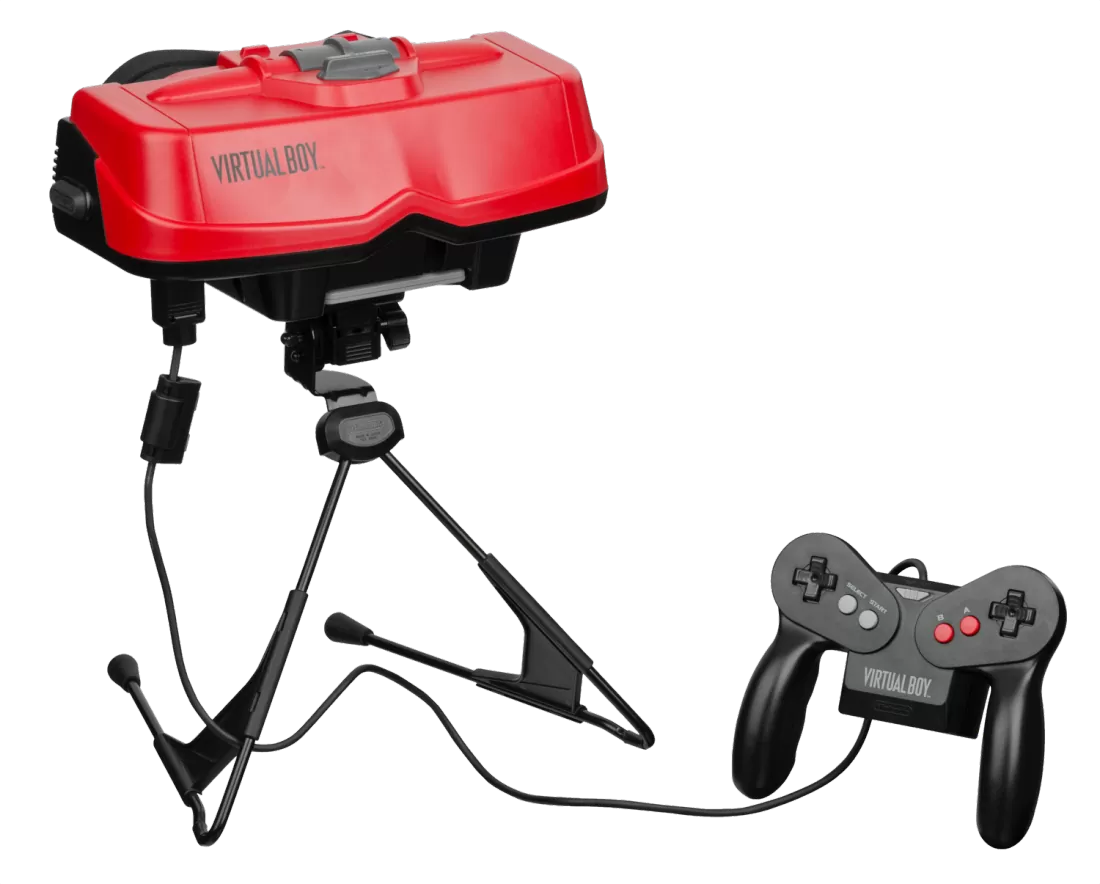
At the 1995 Consumer Electronics Show, Nintendo unveiled a device known as the VR-32 and claimed it allowed players to be immersed into the game they were playing. It would later come to be known as the Virtual Boy, the first home VR device for gaming.
The Virtual Boy was officially released in two markets; Japan received the console on July 21, 1995 while North America received it almost a month later on August 14, 1995. Like most Nintendo consoles of the time, the Virtual Boy came with one game out of the box, Mario's Tennis, which would be the first taste of VR technology for home users.
For 1995, the Virtual Boy was very ambitious and took a lot of risks showcasing an idea that had not yet been explored by home console makers. So how did they accomplish such a feat?
Under the hood
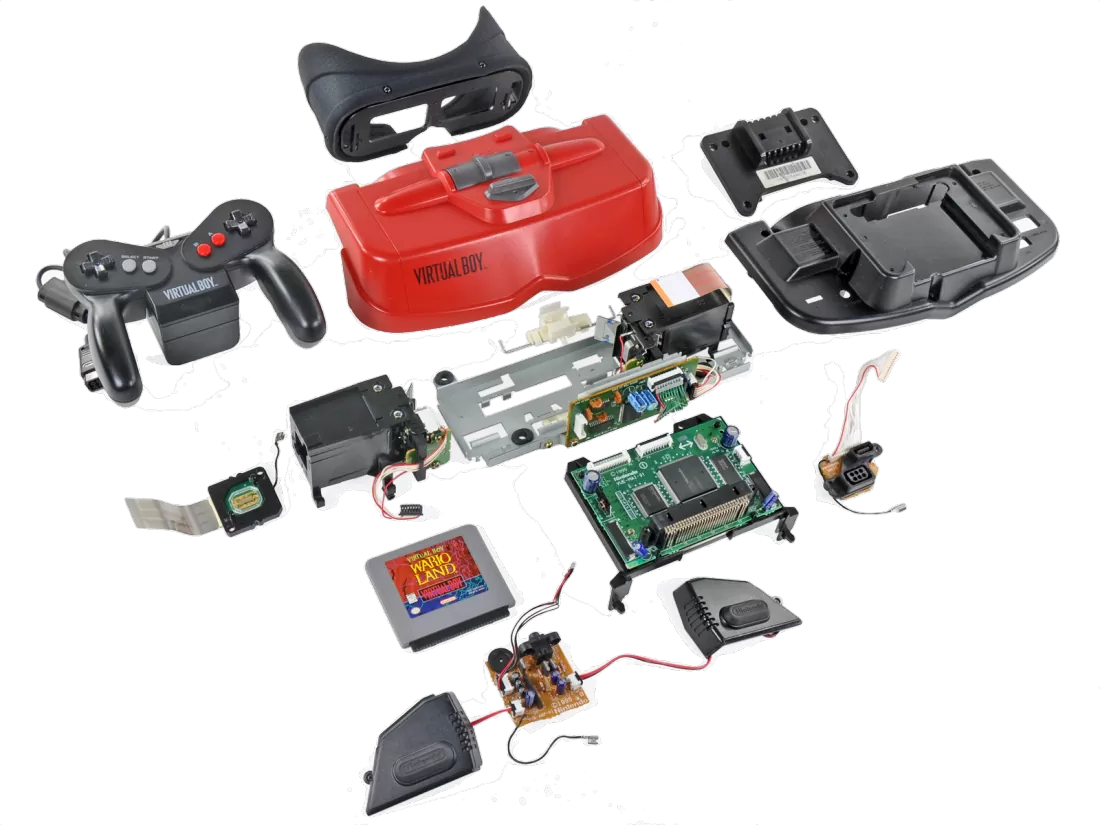 Virtual Boy teardown. Image courtesy iFixItThe Virtual Boy was Nintendo's first 32-bit game console. It was powered by a customized NEC V810, a 32-bit RISC Processor clocked at 20 Mhz. This chip allowed the console to produce higher quality graphics -- at least for a "portable" console at the time -- comparable to what you would expect to see coming from a standard home console. Other specs included 128kb of dual-port VRAM, 128kb of DRAM, and 64kb of WRAM.
Virtual Boy teardown. Image courtesy iFixItThe Virtual Boy was Nintendo's first 32-bit game console. It was powered by a customized NEC V810, a 32-bit RISC Processor clocked at 20 Mhz. This chip allowed the console to produce higher quality graphics -- at least for a "portable" console at the time -- comparable to what you would expect to see coming from a standard home console. Other specs included 128kb of dual-port VRAM, 128kb of DRAM, and 64kb of WRAM.
However, the key element here was the pair of displays (one for each eye) that enabled the 3D effect and the feel of VR to the player. Each screen contained a monochromatic red LED display capable of a 384 x 224 pixel resolution, with four simultaneous shades per 4-pixel column -- black and three reds with approximately 128 levels of intensity -- and a 50hz frame rate. Of course, because of the screen used this meant all the games were colored in black and red, similar to how the Game Boy's were colored in black and green.
The dual screen design allowed the person viewing the Virtual Boy to see two different images at the same time, which created the illusion of 3D using 2D images, while a slider allowed gamers to adjust the screens to better match their eye distance and optimize the experience.
To accompany the VR concept, the controller was setup with 2 directional pads at opposite ends, each with 2 buttons on the front and 2 bumper buttons on the bottom. The controller also served as the point where the power source for the device was hooked up, which had the option of an AC adapter or AA battery pack.
With all this, the Virtual Boy was setup to be a small "portable" game system with power at least on par with the Super Nintendo, while delivering a more virtual experience. While technically a 32-bit game console, a mix of keeping costs and size down kept the console specs closer to the Super Nintendo.
Games and how they played on the Virtual Boy
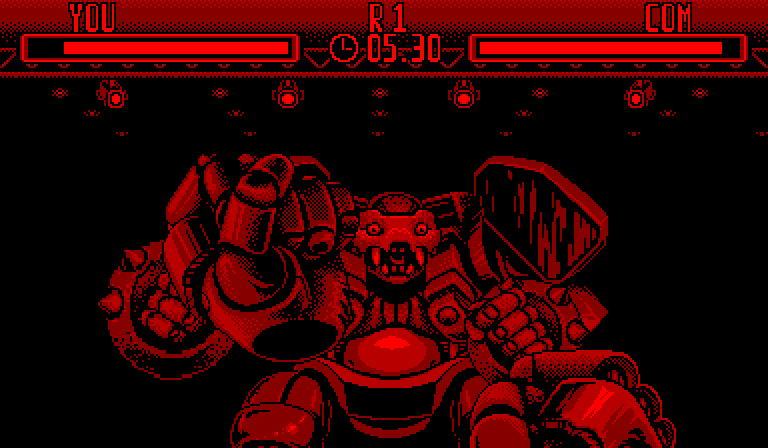
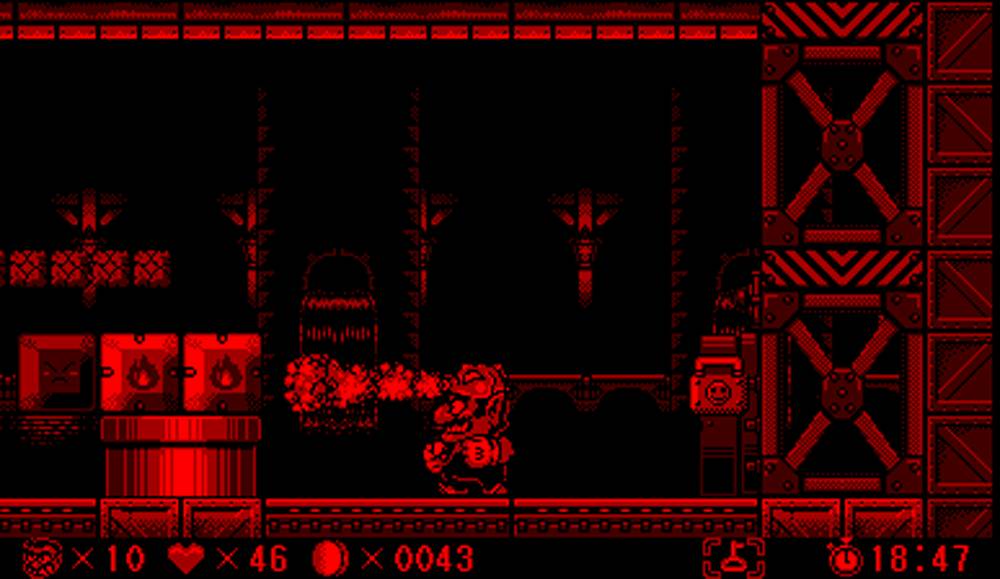
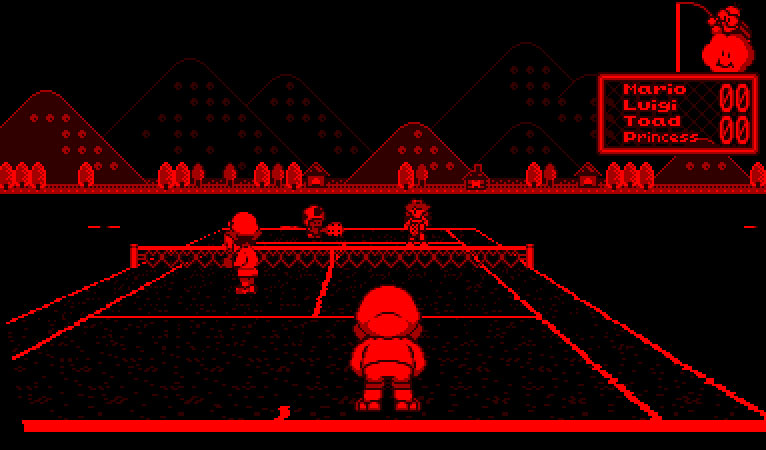
As far as games go, not many were produced. There was a total of 14 games released for the U.S. market and 19 for Japan -- 22 different games total.
Out of all the games available, most are viewed as at least decent and fun games though very few actually took advantage of the virtual experience and instead focused on the 3D aspect. Only two truly attempted to make an experience that felt what the Virtual Boy was going for: Teleroboxer and Red Alarm.
Both are shot in a first person perspective; Red Alarm had first person view as an option, while Teleroboxer was first person only and made use of both directional pads. The latter is probably the best game on the system, if anything for showing what the console was capable of. Unfortunately the rest of games did not take advantage of what made the Virtual Boy unique.
Why we don't remember much about the Virtual Boy
First and foremost, reception of the console was abysmal. The system hanged on for less than a year in the United Stats before it was discontinued. In Japan it fared even worse, the console lasted a paltry five months in store shelves.
The Virtual Boy is Nintendo's second lowest selling console of all time. While there were many reasons that explained the console's poor reception, here are some of the big ones:
- The console was not very easily played on the go. Without a head strap, the Virtual Boy had to be placed on top of a table or on the floor, it wasn't a true portable console as advertised.
- The games, while decent, were awkward to play in a visor and didn't offer a different enough experience to what you would get on the SNES or Game Boy in a much easier fashion.
- The Virtual Boy caused eye strain and headaches after playing -- for some it was minutes for others about an hour, but the result was always the same.
- No multiplayer. While the Virtual Boy contained a special port that was intended for this (labeled EXT Port on the console) no games supported the feature. Waterworld did have a multiplayer function but it involved passing the console around. Though it was said that Waterworld and Panic Bomber originally were programmed to have the functionality, Nintendo did not have any plans to release the console link anytime soon so it was removed.
- It was expensive. The "portable" console retailed for $179.99 in the U.S. Considering the Super Nintendo (and later the Nintendo 64) was launched at $199, the Virtual Boy felt expensive for what it offered. Perhaps most importantly, the Game Boy was $89.99 and offered a robust library of games making the Virtual Boy a hard sell.
Remembering the Virtual Boy
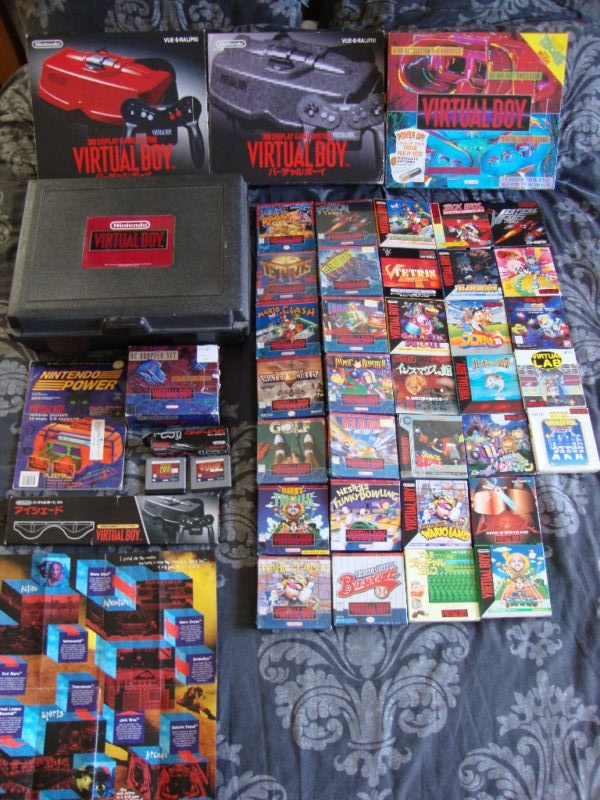 Image courtesy GamesnipedIn spite of a heavy marketing push, it didn't take long before Nintendo deemed the device a commercial failure and quickly discontinued it. Complaints included its high price tag, lack of color and the fact that it was uncomfortable to use. In total, 770,000 units were ever sold.
Image courtesy GamesnipedIn spite of a heavy marketing push, it didn't take long before Nintendo deemed the device a commercial failure and quickly discontinued it. Complaints included its high price tag, lack of color and the fact that it was uncomfortable to use. In total, 770,000 units were ever sold.
The Virtual Boy was simply too early and not quite ready to take on the mass market. The technology behind it was cool and ambitious and we'll always remember it as one of Nintendo's experiments that gave us a taste of things to come in the future.
Now twenty years later, the Oculus Rift is leading the way on the return of VR.
http://www.techspot.com/article/1085...o-virtual-boy/
-
08-12-15, 14:45 #5Tech Ubër-Dominus


- Registo
- Nov 2013
- Local
- City 17
- Posts
- 30,121
- Likes (Dados)
- 0
- Likes (Recebidos)
- 2
- Avaliação
- 1 (100%)
- Mentioned
- 0 Post(s)
- Tagged
- 0 Thread(s)
Oculus VR Exclusives can be modded to work on other hardware
Noticia:With the impending release of commercial virtual reality headsets from the likes of Oculus and HTC/Valve, much talk has turned to what content will be available at launch. Some games and experiences have been announced as Oculus exclusives, but according to the company founder, Palmer Luckey, they won’t be exclusive to the hardware, just to the Oculus platform.
The idea here is that Oculus wants software to run on any HMD, it just isn’t in the business of making an SDK that will work for everything. With that in mind, it will set the quality bar by making games and experiences it partners with exclusive to its store and standards, but if a modder comes along and tweaks the game to make it work on the HTC Vive, Luckey has no problem with that.
“Our goal is not to profit by locking people to only our hardware – if it was, why in the world would we be supporting GearVR and talking with other headset makers?” he said during a Reddit discussion.
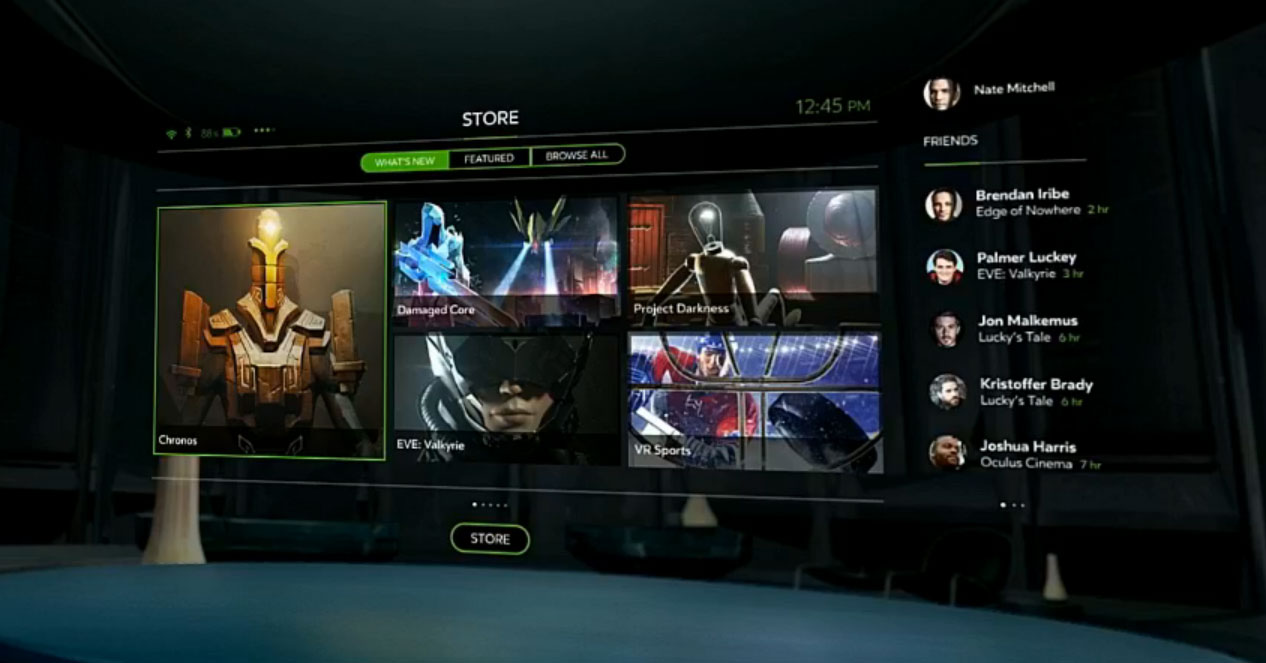
As long as you buy the game from the Oculus store, Luckey doesn’t care what you do with it.
“The issue is people who expect us to officially support all headsets on a platform level with some kind of universal Oculus SDK, which is not going to happen anytime soon. We do want to work with other hardware vendors, but not at the expense of our own launch.”
There are going to be a lot of low end headsets he said, as other companies try to cash in. If someone wants to make a mod for a game to make it work on those, great, but it’s not something that Oculus can officially support, as it would lower the overall quality of what the games can look like and how they operate.
He clarified his point further when someone asked if the Rock Band developers wanted to move their VR game over from the Rift to the HTC Vive, if he would have a problem with that. Luckey said that was fine.
“Only on Oculus” does not mean “Only on Rift”. If it did, we would not be using the same line for both Rift and GearVR, the two headsets our store and platform currently support,” he said.
http://www.kitguru.net/gaming/develo...ther-hardware/
-
09-12-15, 15:18 #6Tech Ubër-Dominus


- Registo
- Nov 2013
- Local
- City 17
- Posts
- 30,121
- Likes (Dados)
- 0
- Likes (Recebidos)
- 2
- Avaliação
- 1 (100%)
- Mentioned
- 0 Post(s)
- Tagged
- 0 Thread(s)
AMD Joins The Immersive Technology Alliance, Alliance VR Council Chair Appointed
Noticia: Daryl Sartain, Director of VR for AMD, ITA VR Council ChairThe Immersive Technology Alliance is a non-profit group comprised of game and film makers, technology makers, standards groups, specialized consultants and academic partners with the goal of making immersive technologies such as virtual reality, augmented reality and stereoscopic 3D successful in the market. (This is the group that runs the Immersed conference.)
Daryl Sartain, Director of VR for AMD, ITA VR Council ChairThe Immersive Technology Alliance is a non-profit group comprised of game and film makers, technology makers, standards groups, specialized consultants and academic partners with the goal of making immersive technologies such as virtual reality, augmented reality and stereoscopic 3D successful in the market. (This is the group that runs the Immersed conference.)
Members of the ITA include notable companies such as Cloudhead Games, Nextgen Interactions, Immersion VRelia and FOVE, but the alliance just announced its highest profile member to date: AMD.
In addition to the new AMD partnership, the ITA announced that the VR Council, which AMD launched in July of this year and includes technology makers, content creators, retail channels and academic institutions, merged with the ITA to form a new VR Council.
This new group will act as a representative division for VR in the Immersive Technology Alliance. An elected VR Council Chair will be elected annually. AMD’s Director of VR, Daryl Sartain, will be its first chair.
"AMD founded the VR Council to bring together the leading authorities on virtual reality to cultivate the industry and create a cohesive vision for its future," said Sartain in a press announcement. "We’ve tracked the ITA and its leadership in immersive technologies for years, and we’re thrilled to be joining forces on this initiative to help drive the evolution of VR."The ITA said the new council is open to all qualified technology and content makers and academic institutions. For more information on how to become a member, see The ITA’s membership page.
http://www.tomshardware.com/news/amd...cil,30720.html
-
16-12-15, 15:28 #7Tech Ubër-Dominus


- Registo
- Nov 2013
- Local
- City 17
- Posts
- 30,121
- Likes (Dados)
- 0
- Likes (Recebidos)
- 2
- Avaliação
- 1 (100%)
- Mentioned
- 0 Post(s)
- Tagged
- 0 Thread(s)
VR to be worth $100M claims AMD
Noticia: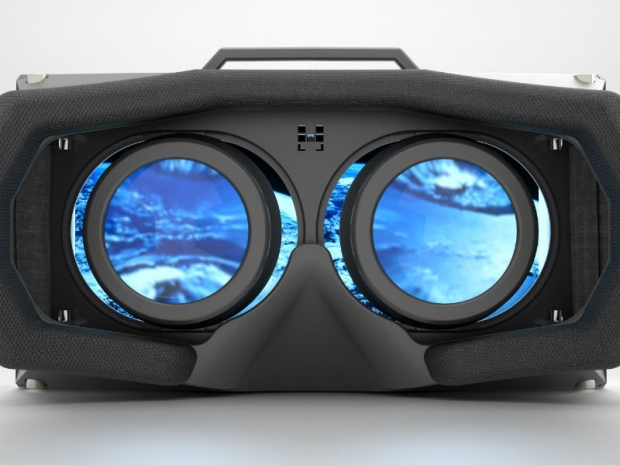
But not until 2020
Enthusiasts, or those with the cash for a Radeon Fury X and Geforce GTX 980 TI or Titan, expect to see a boom of VR devices such as HTC Vive or the Oculus Rift. But according to AMD's CFO the VR business will start making some serious money only in 2020.
The first consumer devices including HTC Vive and Oculus should start shipping in early 2016, unless they are delayed further. You will need quite a high end computer to run these games and demos.
There is severe shortage of VR content but there is little doubt that VR will become successful in a few generations. Devinder Kumar who works as a Chief Financial Officer of AMD believes that AR and VR combined might grow to a $100M by 2020. He talked about it at least week's Raymond James Technology Investors Conference. His exact words were
You mentioned VR, that’s the question of the future. I think we are and then there is also augmented reality, AR is going to be a trend that continues, but from a revenue or significant revenue standpoint we see that the multiyear times and we go out to 2020 timeframe, I’ve seen numbers and terms of offers of $100 million of revenue in that area.He believes that only a few companies can make low latency VR hardware. Radeon Technology Group created and lead by Raja Koduri was definitely one of them. The other will be Nvidia with everyone else lagging behind at least in the beginning.
There will be some mobile phones/ tablets graphics manufacturers that will go after Virtual Reality but since the GPU on these devices is inferior there is no doubt that the experience will be rubbish.
The Oculus or HTC Vive needs at least Geforce GTX 970 or Radeon Fury or faster hardware to offer you good frame rates and experience. These cards have 145W TDP or higher and they perform much better than the Snapdragon 820 / Apple A9 / Snapdragon 8890 or any other mobile SoC. The modern phone SoC is limited to 2W TDP for the CPU and GPU while the tablet part has 5W TDP and there is no chance in hell that you can get similar performance of the 150W TDP part.
http://www.fudzilla.com/news/graphic...-100m-business
-
16-12-15, 15:54 #8Tech Ubër-Dominus


- Registo
- Nov 2013
- Local
- City 17
- Posts
- 30,121
- Likes (Dados)
- 0
- Likes (Recebidos)
- 2
- Avaliação
- 1 (100%)
- Mentioned
- 0 Post(s)
- Tagged
- 0 Thread(s)
Virzoom Rides VR Gaming To Fitness Possibilities (Feet On)
Noticia:
This might be the first article I’ve written and lost weight at the same time, and if virtual reality unlocks the potential that bicycle controller creator Virzoom envisions, it won’t be the last. That's an "if" on top of an "if" given that we can all only speculate and debate the potential success of VR. On the other hand, VR doesn't exist in a vacuum, and its success is also dependent on the success of its ecosystem of content, developers and equipment. Virzoom expects to play a role in all three parts.
Think exercise bike meets VR gaming. Mmm, scratch that. I almost lost you, didn't I? Like everything in the fast-emerging new world that is still more virtual than reality, explaining it is always the most difficult part.
On paper, Virzoom sounds like a trick to make you exercise by sprinkling in a little gaming, kind of like when your mom crushed up aspirin in apple sauce. In a way, that is actually what’s happening here, only instead of applesauce it’s chocolate cream pie. These games are fun, there are more on the way, and, hell, they may just get you to exercise. What's not to like?
The Hardware
Let’s start with the scary part (for some of us), the bicycle. It looks and feels just like your (or your neighbor's) standard home exercise bike. It weighs about 38 pounds and takes up about two feet of floor space from side to side and 28 inches front to back (13 if it's folded up, which it does, a bit like an ironing board). It's a little more than four feet high. The biggest difference from a normal exercise bike is its extended base, which makes it a bit safer as you look into the VR abyss, rather than the real world. Also, you lean — like on a bike — in order to go left or right, taking your movements a little further afield than they would be on a standard exercise bike. VR HMD position tracking enables this, and the extended base prevents the logical accidental outcome.

The bicycle controller has a variety of sensors of its own, collecting data about how fast you’re going and feeding it back to the game for tighter game control, the rate of change on the bike pedals, and change of direction (backward or forward, obviously). There is a resistance adjustment, and that gets measured too, so that if you’re in a multiplayer game, your opponents will know if you’re taking the easy way out.

The bike’s handles are controller paddles, with buttons for navigating menus and firing missiles, or other acts of playful atrocity. The handles will also have heart rate sensors for measuring calories, distance and time, or if you're super competitive, tachycardia.
The bike's data gets transmitted to either a PS4 (with PlayStation VR) or PC (connected to Oculus Rift or HTC Vive) over Bluetooth (LE), using a special dongle. Remember, all that connection is doing is passing data, so that should suffice. It cannot make use of a mobile VR platform like the Samsung Gear VR, because those lack positional tracking.
In the demo I experienced, we used an Oculus DK2, and it was running off of an Asus laptop with an Nvidia GeForce GTX 970M GPU (the Oculus Rift requires a desktop GTX 970 or above, but Eric Janszen, the company's CEO and co-founder, indicated that the Virzoom VR games run fine on the mobile GPU).
ViRZOOM Bike ControllerThe Games
Now the fun stuff. Virzoom has its own development team and had three games ready for demonstration. It will have five by launch. These games are intended to inject some interval training with a little fun, much like Dance Dance Revolution made its players more active, Janszen reminded me.
Virzoom developed its games using the Unity game engine, and it has also created an SDK for its controller. Janszen said that developers using the Unity engine and VZ SDK can target the bike platform, including games already built using Unity, as long as those games were built from the ground up for VR. I asked about other game engines, and Janszen said that Virzoom is open to it but has no existing plans beyond Unity right now.
 Back to the games. These aren’t some fake bike tours on fake roads. One game, called Stampede, had me chasing bandits on horses. The faster I pedaled, the closer I got to them, leaning left or right to align myself and then using the trigger to lasso them off their horse. And onto the next bandit.
Back to the games. These aren’t some fake bike tours on fake roads. One game, called Stampede, had me chasing bandits on horses. The faster I pedaled, the closer I got to them, leaning left or right to align myself and then using the trigger to lasso them off their horse. And onto the next bandit.
Another game, called Go Fast Car, had me pedaling to race other cars. I could use the handlebar controller trigger to slow down on turns and then accelerate on the straightaway, leaning left and right to get in between the other cars. At the end of this game, when all of the noise had stopped, I could hear myself breathing heavily. And that was after a loss.
The last game I played, Pegaso, was more like an open world environment, with me atop a Pegasus, taking off into the sky higher and higher the faster I pedaled. When I slowed down, I lost altitude. In each game (there are a few), the object was to collect gems or energy packets to score points or simply keep going, sometimes in a predetermined amount of time. Grabbing gems and packets at varying distances and different altitudes made for some interesting maneuvering up and down, pedaling faster or slower or leaning side to side, depending on what was necessary. (Talk about interval training.) When I finally removed the DK2, I realized I was perspiring.
Only once during these games did I get a little dizzy; it happened when I let my Pegasus drop to the ground abruptly on an incline — in other words, my horizon was unclear, I was in a first person mode, and the object I was on (virtually) moved quickly. That's your basic recipe for nausea. So avoid that.
ViRZOOM Game DemoAvailability And Price
Starting today, the company is taking pre-orders for the bike on its web site. It’ll work like this: The first 300 orders will get the bike and the five initial games, and any updates of those games over time, for $199.95. After those go, it’s $249.95. Given that none of the marquee HMDs -- the Oculus Rift, HTC Vive, or the Sony Playstation VR -- are actually shipping at present, the pre-ordering is a little baffling. Janszen pointed out that the Virtuix Omni (a VR treadmill that costs a fair bit more than Virzoom) has about 4,000 pre-orders. So what do I know? (A $1,000-plus PC, a fill-in-the-blank-check Rift, a $250 bicycle controller. In for a dime, in for a dollar.)
Also, the company is only saying that the Virzoom will ship in the first half of 2016. A curious thing, though: The company is calling those first 300 units "beta units" and also "early access." In full, CEO Janszen said: "Potentially all 300 beta units (both the first 300 early access as well as later units) will be used by owners of the approximately 200,000 DK2 units shipped (per Oculus’ public estimates) and then later used with CV1, PSVR, and Vive when these products become available." I'm admittedly reading between the lines, but he seems to be saying that the Virzoom beta units could ship before the Oculus Rift (CV1), which either means customers will get them early in 2016, or CV1 is coming late. Or it could just mean that DK2 customers will wait to buy the official CV1.
But there’s more. The company believes there’s a subscription model to be had. For $9.99/month (Virzoom Plus) you get the games, including new versions of them (new races, new cars, new characters, and so on), new games for free, and the fitness data tracking app (just buying the bicycle controller without the subscription fee gets you the heart rate monitoring and data). The app tracks the data over time, and versus others, with goal setting and other aspects you’d see in a FitBit. (In fact, Spencer Honeyman, the company's director of business development, told me there are talks with FitBit).
Finally, you get online multiplayer capabilities with the subscription. The company thinks there will be an eSports competitive element to this. When you buy the bicycle controller, you get the subscription service for free for a month to try out.
The Virzoom is a simple exercise bike intended for the mass market. It isn’t designed as a high-end bike for serious riders and training. The early adopter, Janszen believes, is going to be the gamer.
http://www.tomshardware.com/news/vir...ess,30759.html
-
17-12-15, 20:38 #9Tech Ubër-Dominus


- Registo
- Nov 2013
- Local
- City 17
- Posts
- 30,121
- Likes (Dados)
- 0
- Likes (Recebidos)
- 2
- Avaliação
- 1 (100%)
- Mentioned
- 0 Post(s)
- Tagged
- 0 Thread(s)
Mozilla releases A-Frame making VR web developing easy
Noticia:As much as the idea of walking around websites, rather than interacting with them on a 2D display might seem like a relic from a ’90s future-tech story (anyone remember Net Force?) it’s actually something that some are already experimenting with. It’s hard though, so Mozilla has developed a technique to make it easy. It’s called A-Frame and it lets anyone build a VR website with interaction and navigation/locomotion in no time.
The A-Frame open source library is designed to be as easy to use as possible. The following line is all you need to get started:

However it’s not just the functionality of VR within a website that makes A-Frame so useful, but that it allows for a seamless transition between VR mode and the more traditional 2D variety.
Video Player
00:00
00:10
In the above video we’re shown a user navigating a 3D shopping site, where they can look at a line of clothes in virtual reality. This would be an interesting use of the technology and perhaps in the future you could even load up a 3D model of yourself to see what a product would look like on you.
However it’s not just fun experiences that Mozilla wants to enable with its A-Frame developments, it also wants to make the process of developing such sites as easy as possible. Before A-Frame you’d need to know complicated WebGL to deliver something like this, but not now.

As it stands, A-Frame supports the Oculus Rift DK2 and Google Cardboard on iOS and Android, but will soon support the latest 0.8 runtime and 75Hz head tracking, as per RoadToVR.
http://www.kitguru.net/components/vr...veloping-easy/
-
18-12-15, 13:55 #10Tech Ubër-Dominus


- Registo
- Nov 2013
- Local
- City 17
- Posts
- 30,121
- Likes (Dados)
- 0
- Likes (Recebidos)
- 2
- Avaliação
- 1 (100%)
- Mentioned
- 0 Post(s)
- Tagged
- 0 Thread(s)
CastAR providing refunds to Kickstarter backers, gives out free CastAR
Noticia:Technical Illusions, the AR startup that launched its CastAR augmented reality headset onto Kickstarter in October 2013, has promised to refund the original Kickstarter backers - but with a twist, they will also provide them with a free consumer CastAR system when it launches.
During an interview with GamesIndustry.biz, Technical Illusions' CEO David Henzel-Wallace said: "We're giving every backer who was expecting CastAR hardware a free consumer CastAR system at release and will be fully reimbursing their Kickstarter backings. We will start reimbursement via Paypal at the start of the new year with the last batch going out on February 29". He continued: "We're offering reimbursements to backers who pledged at the hardware tiers - "The Magic Wand" and above. The exception is the Early and Almost as Early CastAR backers, since those backers have already received their Early CastAR prototypes. That said, we'll happily exchange any Early CastAR prototypes for a discount code good for one free consumer CastAR at product launch, if any Early/Almost as Early backers would rather wait for the consumer CastAR and content. A standard Kickstarter Survey will go to all backers this week to collect the necessary info".
GamesIndustry.biz asked the big question, "why do such a generous thing when you could just keep the cash?" Henkel-Wallace replied: "Just because you can do something doesn't mean it's right. We have several reasons why we felt it was best to draw the Kickstarter to a close, and why that should involve reimbursing the backers. First, backers ordered various combinations of hardware (e.g. some just glasses, some glasses plus a magic wand controller, etc). It's hard for developers to write fun games if they don't know what the user will have. This way we can level out the configuration (e.g. our consumer product will have the wand!). Second, our Kickstarter rewards were developer-oriented, but we later learned that most of our backers had really expected a consumer product complete with content. Rather than tell people that they would simply have to write their own games, we decided it's better to take the time to give backers what they expected".
He wrapped up, adding: "Third, we promised, and initially delivered, a lot of background details as our development progressed. But as we moved from development to exploring manufacturing, commercial requirements (such as vendor NDAs) made this harder and harder to do, until we reached the point where we could only either provide vacuous "updates" or say nothing, neither of which our backer community appreciated. Because we wouldn't be here without our Kickstarter community, who gave us the early support and momentum that we needed to get to this point, we didn't want to leave them high and dry. Our backers also helped us prove that there was a large and enthusiastic market for this type of product, and that was important in getting our Series A round. We want to do right by our backers and think that this is the right way to do that as well as move us forward as a business".
The full interview has plenty more, so be sure to check it out.
http://www.tweaktown.com/news/49065/...ree/index.html
-
19-12-15, 14:32 #11Tech Ubër-Dominus


- Registo
- Nov 2013
- Local
- City 17
- Posts
- 30,121
- Likes (Dados)
- 0
- Likes (Recebidos)
- 2
- Avaliação
- 1 (100%)
- Mentioned
- 0 Post(s)
- Tagged
- 0 Thread(s)
Graphine Releases Redesigned Granite SDK 3.0
Noticia:
Graphine released a new version of the Granite texture streaming middleware SDK. Version 3.0 has been redesigned to give artists complete material freedom, and its performance has been streamlined in preparation for use in VR content.
Graphine said that Granite SDK 3.0 is a significant update from version 2.6. Both the layer and caching systems have been redesigned to be more efficient. The company said that that Granite’s layer system was designed to deliver the best possible performance, but it found that a selection of different layer configurations displayed increased memory usage. Graphine said Granite SKD 3.0 has been refined over the last seven months to come up with a solution that it said “ensures great performance and total material freedom while removing any negative impact on system resources.” The company also said that Granite SKD 3.0’s design allows for plenty of future optimizations to increase performance further.
Graphine believes that the feature artists will benefit most from is the total material freedom. The company said that Granite SKD 3.0 “enables the use of different resolution textures per stacked texture, and many different layer configurations per scene” without impacting memory and disk usage or bandwidth. Granite SDK also allows for multiple types of textures to be combined to create a single stacked texture.
GraniteGraphine said these optimizations improve performance by reducing CPU and GPU load by as much as 50 percent. The company said this will help pave the way for high quality textures in virtual reality while maintaining the desired 90 frames per second.
The Granite SDK 3.0 update is available now for current license holders. The company allows for free trials if you’d prefer to try before you buy.
http://www.tomshardware.com/news/gra...sed,30788.html
-
21-12-15, 13:50 #12Tech Ubër-Dominus


- Registo
- Nov 2013
- Local
- City 17
- Posts
- 30,121
- Likes (Dados)
- 0
- Likes (Recebidos)
- 2
- Avaliação
- 1 (100%)
- Mentioned
- 0 Post(s)
- Tagged
- 0 Thread(s)
Futuremark’s 3DMark 2016 “Holiday Beta” Offers Users A Taste of Virtual Reality With VRMark
Futuremark has a couple of updates ready for their 3DMark benchmarking suite in 2016 and they released one of the update today in the form of their latest Holiday Beta update. Futuremark is offering a special update to their users, called the 3DMark Holiday Beta which will provide new features coming to the 3DMark benchmark in 2016.

3DMark Holiday Beta Update Adds VRMark – First Virtual Reality Benchmark
Futuremark is an enthusiast focused graphics benchmarking suite but over the time, it has been used by the casual and gamer community too to test their PCs, notebooks and even mobility devices. With VRMark, the software now focuses towards the growing market surrounding Virtual Reality as developers and consumers become more attracted to Virtual Reality given the experience it provides to end users. 3DMark is going to offer a preview of their latest VRMark test which will revolve around four classing 3DMark scenes. All three scenes will be free to walk through however the benchmarking suite will be available later. Enthusiasts can measure the performance in Virtual Reality but the preview won’t produce a score as of yet. All VRMark tests will be compatible in Virtual Reality with Oculus Rift and HTC Vive headsets. The full list of supported Virtual Reality headsets can be found here.
Aside from the VRMark preview, 3DMark will also offer more tests which they have teased as “Coming Soon”. Futuremark has also created a brand new UI for 2016 that’s mentioned to be faster, more flexible and more intuitive. The 3DMark software will from now on provide you a list of recommended benchmark tests for your system based on your hardware specifications. Users who still want to run the rest of the benchmarks can do so by installing and running them from the Benchmark screen that is added to the new interface. One of the good things about the new update is that each of the test can now be downloaded and installed individually and updates will also be provided for each benchmark in that way. Of course, Futuremark provides a detailed FAQ on how to avail the 3DMark Holiday Beta update:


How to join the 3DMark Holiday BetaLike I stated before, there’s a lot going on with 3DMark as it enters 2016. We already know that Futuremark is developing a new test known as “Time Spy” for 3DMark which is one of the many DirectX 12 tests which will be available with the updated version in Q1 2016. The new 3DMark will focus around the tech and features which DirectX 12 is going to offer in future next-generation AAA titles. The benchmark will include several game tests, one of which known as “Time Spy” was showed at the event that revolves around a museum filled with highly detailed objects.
The beta is open to everyone who owns the paid version of 3DMark on Steam. Sorry, demo users. To join the beta, follow the steps in our community post.
The benchmarks have not changed. You can use the Holiday Beta to test your PC and compare scores as usual. You can leave the beta and revert to the public version of 3DMark at any time.
How to give feedback and report problems
For any issues with the new interface, or with the VRMark Preview, please add a reply to this post in the 3DMark Steam Community. For a list of known issues, click here.
Advertisements
You can get support for any other 3DMark problems through our support page[www.futuremark.com] and in the 3DMark community on Steam.
The whole tests makes use of 3D rendering using DirectX 12 API to test performance of graphics cards. The benchmark test runs at 2K or 1440P resolution and is 5 times (5x) more heavier than 3DMark Fire Strike which is available in the 3DMark 2013 benchmark suite. That means that the graphics test will require some serious horsepower to render and only the best performance cards will be able to score decent numbers in the test.

Test VR performance, latency and accuracy
Delivering a great VR experience relies on overcoming significant challenges. VRMark uses a combination of software and hardware to measure VR system performance, latency, and accuracy, the key components in creating convincing VR experiences.
Designed primarily for manufacturers, analysts and press, VRMark tests a system’s ability to deliver high quality virtual reality experiences for a range of content types from photos and video to games and simulations.
Lab-based VR testing and verification
VRMark is our first major product announcement since we joined forces with UL. Combining the expertise of both companies, we offer professional lab-based VR testing with precision instruments and verification of performance claims to manufacturers and other customers.
VRMark is the first component of a comprehensive VR offering from UL and Futuremark that also includes the development of new standards and certification programs to protect the health, safety and well-being of VR users. via Futuremark
-
23-12-15, 14:37 #13Tech Ubër-Dominus


- Registo
- Nov 2013
- Local
- City 17
- Posts
- 30,121
- Likes (Dados)
- 0
- Likes (Recebidos)
- 2
- Avaliação
- 1 (100%)
- Mentioned
- 0 Post(s)
- Tagged
- 0 Thread(s)
We take a quick look at Futuremark's new VR benchmark - VRMark
Noticia:Futuremark has been around for what feels like forever, with the Finnish company being one of the first on the market with a mainstream benchmark that stressed your PC. Everyone remembers 3DMark and the iconic Matrix-like tests from 3DMark 2001... well, they have come a fair way since then!
Fast forward to today, and we have Futuremark on the precipice of releasing a DX12-based 3DMark in the New Year, as well as VRMark. Futuremark recently released the VRMark Preview with a new UI into 3DMark as part of a holiday beta. The 2016 version of 3DMark will include a benchmark for VR headsets like the Oculus Rift and HTC Vive, so the VRMark Preview is great to see out before the end of the year.
VRMark in its current state, works with the Oculus Rift and the HTC Vive - but it will also work as a monitor-only benchmark so you can see what it's all about. I decided to give it a run on my new MSI GT72 Dominator Pro G Series gaming laptop, which is powered by the full GeForce GTX 980 from NVIDIA - this isn't a cutdown GTX 980M folks, this is the real deal. The GTX 980 on this laptop is a mobile gaming beast, and is more than capable of playing games on my Oculus Rift DK2 headset, so I thought I'd use the MSI gaming laptop to test out VRMark.
VRMark is an experience, not just a benchmark
This is something that I had to get used to... with most VR games, applications and experiences you have to constantly turn your head in the world to take it all in, or even play the game at all. After years upon years of benchmarking my PCs, running 3DMark was a set-and-forget affair after the first few times of watching the graphics display across the screen.
The new VRMark isn't just that - a set-and-forget benchmark - it's an experience. The current "Holiday Beta" of 3DMark is actually quite impressive with a VR headset on, as you can look around the world that Futuremark places you in. There are all sorts of things going on in the world, with various 'setpieces' to look at - in front of you, to the sides and even above you. It's an impressive thing to see, so I'm hoping Futuremark keep with this theme when it comes to VRMark's release in 2016. I would actually love to see Futuremark include an experience-style part of VRMark, where you could walk around or explore the benchmark.
VRMark is a great first step for VR benchmarking
VR headsets are going to really take off next year, and before you spend $300+ on a new VR HMD, you want to know if your PC is up to rendering 2K at 90FPS... right? This isn't 1080p 60FPS gaming, this is much higher, so benchmarks are going to be incredibly important for VR headset manufacturers like Oculus and HTC. Futuremark is on the forefront of this, and I applaud them.
I hope we see some totally different benchmarks - bringing back the old 3DMark 2001 test that was so Matrix-like, so I can have a VR benchmark where I have to dodge bullets... come on, Futuremark - you can do it.
http://www.tweaktown.com/tweakipedia...ark/index.html
-
24-12-15, 14:45 #14Tech Ubër-Dominus


- Registo
- Nov 2013
- Local
- City 17
- Posts
- 30,121
- Likes (Dados)
- 0
- Likes (Recebidos)
- 2
- Avaliação
- 1 (100%)
- Mentioned
- 0 Post(s)
- Tagged
- 0 Thread(s)
Second Life wants to make VR a more social activity with new project
Noticia:Second live developer, Linden Labs, is working on a new product, called Project Sansar, that wants to integrate a more natural and social experience with upcoming VR solutions.
If there's one thing about the incoming VR revolution, it's that not everyone is necessarily convinced that it's here to stay. Is this stereoscopic 3DTV all over again? That's a fair question, because to some it seems just a bit gimmicky at first glance.
But the makers of Second Life want to make VR a social activity, so that it can potentially become a lot more appealing to a much wider audience. Speaking with PSFK, the CEO of Linden Labs, Ebbe Altberg spoke a little on what they see as the future of VR. Second Life already has Oculus Rift support as of 2014, which lets you immerse yourself like never before, but they want to significantly expand upon that.
Altberg says that "Social will be HUGE in virtual reality," and he even went on to explain that there already is around $60 million being spent by users and businesses on an annual basis on developing for Second Life, meaning that there's large potential for growth in that sector.
The idea behind their new Project Sansar is to transcend physical boundaries, letting you more easily experience world's in ways you may not have thought of before. But it doesn't want to do it in the same way that VR experiences, like Elite: Dangerous or Star Citizen already do, but want to make it social and far more accessible to everyone. In essence, they want it to be a natural extension of their surprisingly successful Second Life virtual world platform.
Altberg closed by saying that "We want to lower the barrier of entry for VR experience creation. Project Sansar will do for virtual experiences what WordPress has done for the web: embower a broad range of people to create with professional quality and reach global audiences."
Altberg and his company, then, want to create their own SDK that's likely interchangeable and compatible with all the available VR solutions, letting you make to your hearts content, and not having to be a developer. It'll have huge implications for the future of VR.
http://www.tweaktown.com/news/49202/...ect/index.html
-
25-12-15, 09:40 #15Tech Ubër-Dominus


- Registo
- Nov 2013
- Local
- City 17
- Posts
- 30,121
- Likes (Dados)
- 0
- Likes (Recebidos)
- 2
- Avaliação
- 1 (100%)
- Mentioned
- 0 Post(s)
- Tagged
- 0 Thread(s)
Finexus uses magnets to track your finger movements in VR
Noticia:The team over at University of Washington has been playing around with real-time tracking of fingers in the VR world, thanks to the power of magnets.
Oculus is working with the University of Washington to develop a magnet and sensor combination that will allow natural use of your hands in the VR world, instead of using sticks or gloves that requires line of site. The project is called Finexus, which uses magnets that are the size of fingernails, which are placed on top of a user's fingertips.
From there, they can determine the exact location of your fingers in the 3D space. The magnets claim to be accurate up to just 1.3mm, too. They don't require a line of sight with a camera, so they can be used for nearly anything, and in endless positions or body orientation. If the Finexus project ends up becoming real, which I think it will, it could be a very natural input device for VR, and especially the Oculus Rift, since the Facebook-owned VR startup is involved.
http://www.tweaktown.com/news/49211/...-vr/index.html
Informação da Thread
Users Browsing this Thread
Estão neste momento 1 users a ver esta thread. (0 membros e 1 visitantes)







 Responder com Citação
Responder com Citação






Bookmarks